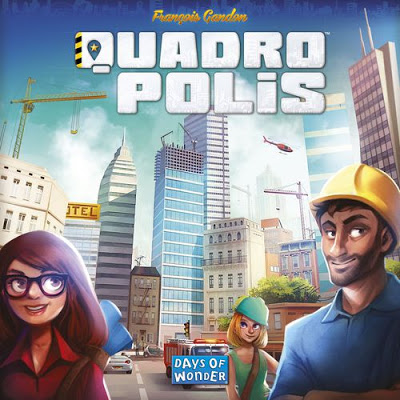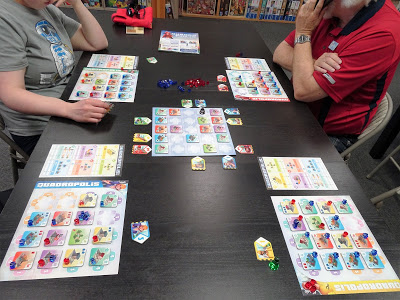As mayor of a growing city you control whether your citizens will live in an urban paradise or an urban jungle.

Classification Family Strategy Game, City Building
Mechanics Tile Placement, Set Collection
Publication Days Of Wonder, 2016
Ages 8+
Time 30 – 60
Players 2 – 4
Description
Quadropolis is a game with easy
mechanics and deeper game play than it first appears. With double-sided individual player boards
and double-sided architect tiles, Quadropolis provides two levels of play; Classic which allows for an easier
discovery of the game mechanics and various strategies, and Expert which
introduces new buildings and some rule changes to provide more challenge.
mechanics and deeper game play than it first appears. With double-sided individual player boards
and double-sided architect tiles, Quadropolis provides two levels of play; Classic which allows for an easier
discovery of the game mechanics and various strategies, and Expert which
introduces new buildings and some rule changes to provide more challenge.
The Classic game lasts
4 rounds with players taking 4 turns per round.
The central game board has 25 squares laid out in a 5×5 grid where
various types of building tiles are randomly placed at the beginning of each
round. Each round has its own set of
buildings. A player’s turn consists of playing
1 of their 4 architects next to a column or row on the central game board,
taking the building tile associated with the number on that architect, and
placing the building tile on the most advantageous space on their own city
board also corresponding with the number of that architect. Each player has 4 architect tiles numbered 1
through 4. On a round, players must use
each architect and can only use each one only once. As each round progresses, it gets
increasingly more difficult to get the building you want with the architects
you have left. Just to make things
interesting, there is an Urbanist pawn that gets placed where the last
building was taken. The next player
cannot not claim a building in the row or column that is occupied by the Urbanist.
4 rounds with players taking 4 turns per round.
The central game board has 25 squares laid out in a 5×5 grid where
various types of building tiles are randomly placed at the beginning of each
round. Each round has its own set of
buildings. A player’s turn consists of playing
1 of their 4 architects next to a column or row on the central game board,
taking the building tile associated with the number on that architect, and
placing the building tile on the most advantageous space on their own city
board also corresponding with the number of that architect. Each player has 4 architect tiles numbered 1
through 4. On a round, players must use
each architect and can only use each one only once. As each round progresses, it gets
increasingly more difficult to get the building you want with the architects
you have left. Just to make things
interesting, there is an Urbanist pawn that gets placed where the last
building was taken. The next player
cannot not claim a building in the row or column that is occupied by the Urbanist.
When played on a
player’s individual city board, buildings can bring inhabitants, energy units,
or victory points. Inhabitants and
energy units will be used to activate buildings at game end. Only activated buildings will be scored. Balance between buildings, inhabitants, and
energy units is essential. Players with unused inhabitants and energy units
will receive one negative victory point for each.
player’s individual city board, buildings can bring inhabitants, energy units,
or victory points. Inhabitants and
energy units will be used to activate buildings at game end. Only activated buildings will be scored. Balance between buildings, inhabitants, and
energy units is essential. Players with unused inhabitants and energy units
will receive one negative victory point for each.
After 4 rounds of 4
turns each have been completed, each of the 6 different types of buildings are
scored. Tower blocks are scored by how
high they are up to a max. of 4 floors.
Shops are scored by the number of inhabitants they have attracted as
customers. Public service buildings
score by the number of different sectors they occupy. Parks score based on the number of Towers
adjacent to them. Factories score for
having Shops and Harbors adjacent to them.
And Harbors score by how many in a row and/or column. The player with the most victory points wins.
turns each have been completed, each of the 6 different types of buildings are
scored. Tower blocks are scored by how
high they are up to a max. of 4 floors.
Shops are scored by the number of inhabitants they have attracted as
customers. Public service buildings
score by the number of different sectors they occupy. Parks score based on the number of Towers
adjacent to them. Factories score for
having Shops and Harbors adjacent to them.
And Harbors score by how many in a row and/or column. The player with the most victory points wins.
Once the Classic game
is mastered, flip the architect tiles and the player’s city boards over to the
expert side. Architect tiles are now
numbered 1 through 5 and are all placed in a central pool for every player to
pull from. Player’s city boards have a
fifth sector to fill and another building type to construct, the Office
Towers. In addition, there will be 5
rounds of 4 turns each. Office Towers
are scored based on a combination of adjacency and number of floors. Scores for all other buildings are amped up
for the additional type of building, additional sectors and/or additional rows
and columns.
is mastered, flip the architect tiles and the player’s city boards over to the
expert side. Architect tiles are now
numbered 1 through 5 and are all placed in a central pool for every player to
pull from. Player’s city boards have a
fifth sector to fill and another building type to construct, the Office
Towers. In addition, there will be 5
rounds of 4 turns each. Office Towers
are scored based on a combination of adjacency and number of floors. Scores for all other buildings are amped up
for the additional type of building, additional sectors and/or additional rows
and columns.

Play the family
friendly Classic mode for a quicker and lighter game. Go to the Expert mode when you are looking
for a deeper gaming experience. Either
way Quadropolis will keep you engaged throughout.
friendly Classic mode for a quicker and lighter game. Go to the Expert mode when you are looking
for a deeper gaming experience. Either
way Quadropolis will keep you engaged throughout.
~ ~ ~~ ~ ~~ ~ ~~ ~ ~~ ~ ~~ ~ ~~ ~ ~~ ~ ~~ ~ ~~ ~ ~
Continue to check in for the latest in board games.
~ ~ ~~ ~ ~~ ~ ~~ ~ ~~ ~ ~~ ~ ~~ ~ ~~ ~ ~~ ~ ~~ ~ ~
Come and visit us at 30 NW 2nd Street in Historic Downtown Gresham. We have a full range of family games, strategy games, Euro-style games, war games, card games, dice games and more. Also for the puzzle enthusiasts we carry quality puzzles from Ravensburger, White Mountain, Cobble Hill, and Dowdle.
We proudly serve Gresham and the greater Portland and Vancouver area.